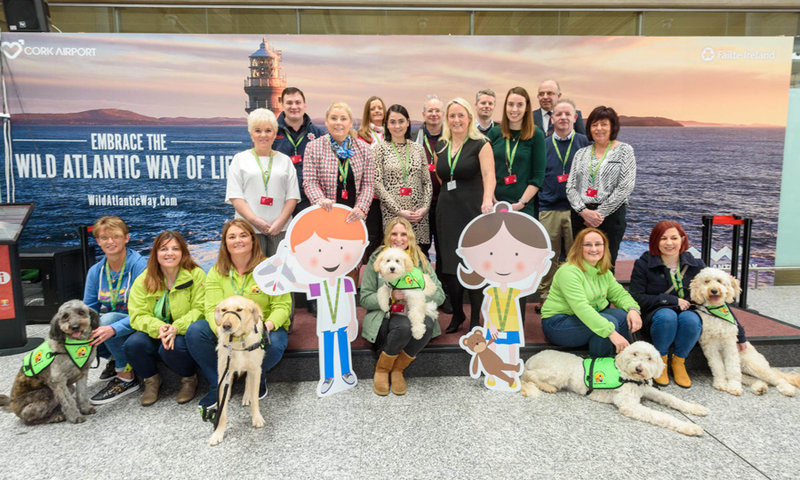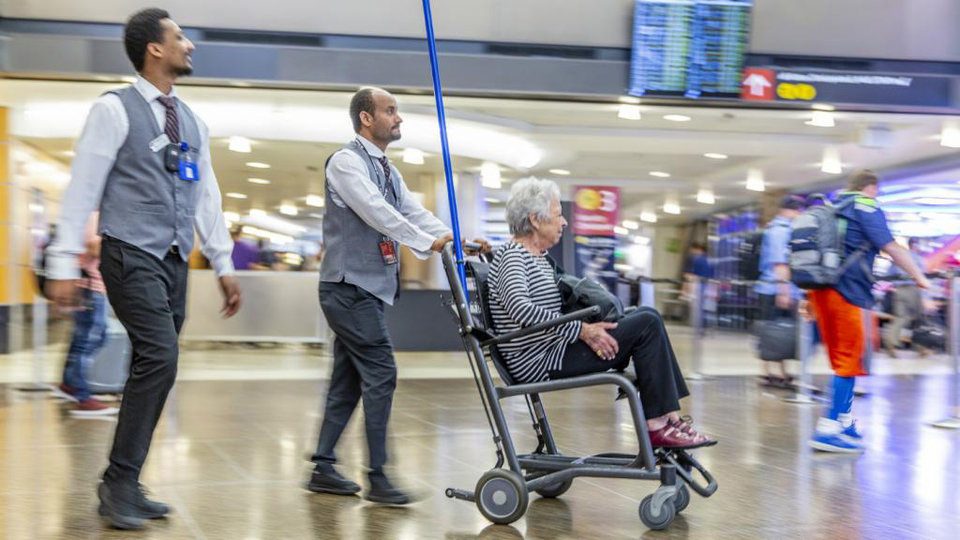Passenger Focus
Helping disabled passengers in 2019
Airports are becoming increasingly accommodating towards passengers with disabilities, often with the help of technology. From virtual reality to automation, Varsha Saraogi lists the initiatives that airports implemented in 2019 to help make air travel an easier experience for disabled passengers.
For many disabled people, an aviation journey free of barriers still remains a distant pipedream. Airports, airlines and regulatory bodies have therefore been implementing initiatives with the aim of making air travel more accessible and manageable for persons with reduced mobility (PRM).
Along with wheelchair assistance, airports are developing other forms of assistance for disabled passengers. UK airports, for instance, now have enhanced disability awareness training to ensure staff can assist people with both visible and non-visible disabilities, according to a report published by the UK Civil Aviation Authority (CAA) in 2018.
The International Air Transport Association’s (IATA) 75th Annual General Meeting (AGM) held in June 2019 approved a resolution to improve air travel for the estimated one billion people living with disabilities worldwide. The AGM called upon governments to use IATA’s core principles for accommodating passengers with disabilities.
The principles aim to bring the travel sector together with governments to enforce regulations and provide services that disabled passengers expect on a global level. In European airports, for instance, passengers have a legal right to get help navigating airports, accessing facilities and checking in.
From using technology to improving training programmes for airport personnel, here are some of the initiatives implemented by airports for persons with reduced mobility in 2019.
Image:
Self-driving wheelchairs at Abu Dhabi International Airport
In a partnership with Etihad, personal electric vehicle supplier WHILL and information technology company SITA, Abu Dhabi International Airport launched autonomous wheelchairs that allow travellers with reduced mobility to move around the airport without the assistance of a staff member.
These vehicles are equipped with sensors to identify obstructions and offers an automatic stop function. In addition, the airport is working towards developing other features to be rolled out in the future, which include real-time gate and boarding time updates for guests.

Abu Dhabi’s new autonomous wheelchairs. Image: Etihad
Those who are not comfortable with the autonomous wheelchair can choose the traditional assistance method and have airport personnel help them.
The ongoing trial has been planned to last until December 2019 and will involve extensive testing and mapping of the airport environment to facilitate autonomous movement, after which the wheelchairs could be rolled out across the airport facility.
Eero Knuutila is Head of Service Development at Helsinki Airport.
Image courtesy: Helsinki Airport
Boise Airport capitalises on virtual reality
Travelling can be challenging for children and adults with autism as the entire process before boarding an aircraft makes them feel quite anxious, according to autism charity Autism Speaks. It said that for autistic people, taking flights for the first time is a daunting experience as they are unprepared and unaware of what to expect.
To help passengers with autism navigate the airport environment before going in person, the city of Boise in Idaho, US collaborated with Boise State University to create a virtual reality experience. Launched in September 2019, Airport Tour is a 360° video experience that has been implemented at Boise Airport. Apart from being available at the airport itself, the VR experience can also be used at the Boise Library before passengers visit the airport.

Boise, Idaho, US.
It starts with standard airport procedures such as checking in, walking through the security line, and sitting inside an aeroplane before take-off. In a statement, Boise State University said that with the help of modern technologies such as virtual reality, children or adults are able to familiarise themselves with airport procedures in a comfortable setting, therefore making the real experience smoother.
United Airlines hires special Olympics athletes as ambassadors
In October 2019, United Airlines hired special employees to help disabled travellers navigate O’Hare International Airport. The airline also aims to motivate them to be more independent in mainstream society.

United Airlines hired Paralympians to assist disabled passengers. Image: United Airlines
In a statement, United Airlines said that it is promoting the idea that employing people with disabilities has a positive influence on a company’s success. This move would then motivate people with disabilities to become more comfortable when travelling via air, the airline said.
The airline hired 20 Olympics athletes and trained them in airport operations, after which they assisted passengers at check-in and prepared them for departure at the gate.
Cork Airport introduces sunflower lanyard scheme
In March this year, Cork Airport initiated a lanyard scheme where people with hidden disabilities - autism spectrum disorder, epilepsy and acquired brain injuries - are able to easily ask for extra support when travelling through Cork Airport with the help of a lanyard.
The 'Sunflower Lanyard' initiative, already in use in airports including Heathrow and Gatwick, allows passengers to discreetly identify themselves to staff. The project is part of an initiative by OCS, the global passenger assistance services provider.

Cork Airport was the first ROI airport to roll out the lanyard scheme. Image: Cork Airport
Becoming the first airport in the Republic of Ireland to roll-out the lanyard initiative, Cork airport even adopted new signage for accessible toilets. The airport is committed to going the extra mile for autistic passengers through the provision of books intended to help them cope with new situations.
Sea-Tac International improves signage and introduces induction loops
Seattle-Tacoma International Airport in the US announced new services in October 2019 to make travel more accessible and less stressful for those with hidden disabilities.

Seattle-Tacoma International Airport, US. Image: Sea Tac Airport
The airport said in a statement that it’s making strides to help passengers safely navigate a crowded airport by improving signage and increasing options for travel to and from the airport.
It implemented initiatives such as sunflower lanyards and installed hearing loops and improved its design with new curb cuts to make the structure more conducive to PRM.
Gatwick’s new training programmes for staff
Gatwick Airport has come a long way since it was named as one of the worst airports in providing access for disabled travellers by the CAA in 2018.
In October 2019, Gatwick announced an independent panel – comprising experts in the travel needs of disabled passengers – to help shape Gatwick’s accessibility strategy and improve services for disabled passengers.
In September 2019, it announced that over 2,500 staff across 14 different businesses on the airport campus received training to recognise and help people with dementia and that it plans on continuing to do so.

Gatwick opened a sensory room to help accommodate autistic passengers. Image: Gatwick Airport
During the same month, it also released three new videos which have been developed to encourage people with disabilities to travel. Showing the journey through the airport from the perspective of someone in a wheelchair and someone who is partially sighted, it aims to encourage disabled people to travel.
Gatwick Airport claimed that it became the first UK airport to open a sensory room after a consultation with the National Autistic Society. It said it upgraded its infrastructure to accommodate blind and visually impaired passengers with the assistance of a tool provided by the Royal National Institute of Blind.
Blind and visually impaired passengers at Gatwick can now also receive 24/7 guidance through the airport by using a free, on-demand service via the Aira app. Users will be put through to an agent, who will use live footage from the camera on the passenger’s mobile phone to guide them through the airport, help them read documents and find their bag on the luggage carousel.